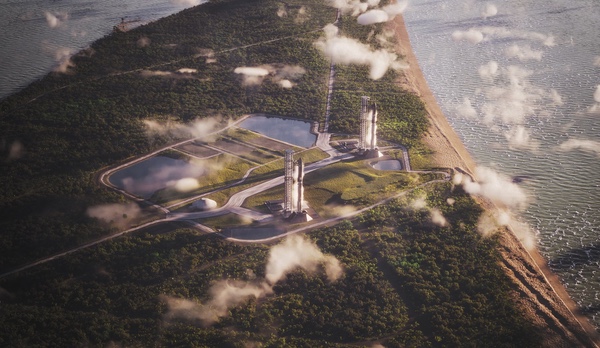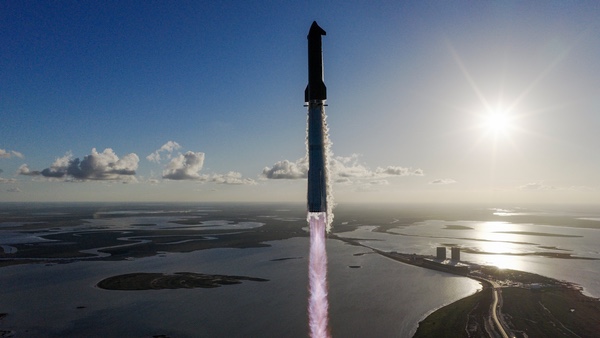Promising to be a good neighborby Jeff Foust
|
| “It’s something that’s not been on the range before, so they need to do a very thorough and careful analysis of that,” Bruno said of Starship at Cape Canaveral. |
The flight was the last of version 2 of Starship, and during the webcast SpaceX talked up the changes to come on version 3, from upgraded Raptor engines to interfaces on the upper stage that will allow Starships to dock with each other in orbit, enabling the in-space propellant transfer needed for missions beyond Earth orbit, like lunar landings. “Bottom line, this is the Starship we’re planning to use for all of our next major milestones,” one webcast host said of version 3.
People in Florida were watching the launch in more ways than one. The timing of the launch, late in the day in Texas, meant that the sun had set in Florida but Starship was still illuminated as it passed to the south. Many Floridians reported seeing Starship and its backlit plume in the skies.
In the not-too-distant future, those people will have the opportunity to see Starship launches close up. While Starbase will continue to host upcoming Starship launches, with a second launch pad built there, the vehicle’s future involves launches from the Cape.
SpaceX has been working for years to bring Starship to Florida and has already built launch infrastructure for the vehicle at Kennedy Space Center’s Launch Complex 39A; the tower and other equipment for Starship is often seen in coverage of Falcon 9 launches there. SpaceX is working with NASA, the FAA, and other agencies on an environmental impact statement (EIS) for Starship launches there, while a separate review is underway with the Department of the Air Force to support Starship launches from Cape Canaveral’s Space Launch Complex (SLC) 37, previously used by the Delta IV.
If those environmental reviews are finalized, SpaceX would be able to perform 44 Starship launches a year from LC-39A, as well as 88 landings (44 each of Super Heavy and the Starship upper stage), as well as 76 launches from SLC-37, along with 152 landings. By contrast, SpaceX is currently approved for 25 launches and 50 landings a year from Starbase.
The prospect of adding 120 launches and 240 landings a year to Cape Canaveral, particularly of a vehicle the scale of Starship, has raised concerns both inside and outside the spaceport. Other launch companies wonder what impacts Starship launches will have on their operations, from the availability of propellants to hazard zones that could disrupt their work.
The EIS for Starship launches from LC-39A, for example, showed restriction zones for tests and launches extending south to include SLC-41, the pad that United Launch Alliance uses for Atlas and Vulcan; for launches, the zone stretches west almost to the Vehicle Assembly Building.
Tory Bruno, CEO of ULA, said in an August media briefing that the disruption caused by Starship launches could be “unprecedented” given the vehicle’s size, suggesting it could affect other launch providers as well. The EIS for Starship launches from SLC-37 showed restriction zones for launches extending from SLC-41 south to sites assigned to emerging launch vehicle companies like Relativity Space and Stoke Space. It stops just short of SLC-36, the pad Blue Origin uses for New Glenn.
“It’s something that’s not been on the range before, so they need to do a very thorough and careful analysis of that,” Bruno said of those Starship reviews. “We are counting on them to do it so we can all use the range.”
| “There is the potential that there is going to be significant impact to commercial aviation,” a Tampa airport official said of Starship launches from the Cape. |
An online public meeting in early September about the LC-39A study brought in people concerned about other effects. The restriction zones for launches would require closing Playalinda Beach, a popular beach just north of KSC, dozens a times of year for tests and launches. One person suggested it would force people to go to beaches further north, including one that has long been a clothing-optional beach, causing a clash of cultures.
Others worried about the impact of the launches themselves, which would stretch far from the launch pad given the size of the vehicle. The study found that up to 14% of residents in nearby communities would be awakened by the noise of a nighttime launch, and up to 82% by the sonic boom from a Super Heavy booster landing.
Launch noise also posed a “substantial” risk of damage claims within several kilometers of the pad, all within the boundaries of Kennedy Space Center. Outside KSC, the study found a 1-in-1,000 risk of damage. At the public hearing, people worried about the impacts the noise and vibration would have, particularly on older homes.
The effects of Starship launches from Florida could spread much further in terms of its impact on aviation. Launches would create aircraft hazard area (AHA) corridors extending well into the Atlantic. “AHAs may necessitate the closure of dozens of coastal and deep-water oceanic airways over the Atlantic Ocean, requiring substantial aircraft rerouting to avoid the AHAs,” the LC-39A study stated.
Reentries would also create AHAs from Mexico and Central America to Florida as Starship reentered from west to east to land back at KSC. “AHAs may necessitate the closure of dozens of coastal and deep-water oceanic airways” from the Pacific to the Atlantic Coast, the report stated. “Multiple airports may require departure stops due to the overlying AHA.”
The report found that launches could create delays ranging from 40 to 120 minutes for launches and 40 to 60 minutes for landing. That could affect, during peak travel times, as many as 400 aircraft for launches and 600 for landings.
That has raised alarm bells for both airlines and airports. Among those who spoke at the online public meeting in September was John Tiliacos, chief operating officer of Tampa International Airport.
“There is the potential that there is going to be significant impact to commercial aviation,” he said. “That’s something that the FAA needs to give consideration to and, frankly, come up with a plan to mitigate that.”
Not everyone who participated in the public hearing was worried about Starship launches. “I’m pro-SpaceX and I love everything they’re doing,” said one person, Max West. “There will be some minor little sacrifices that we have to make. The turtles and the nudists will have to migrate, maybe. That’s the cost you have to pay for the incredible stuff that’s happening.”
 SpaceX wants to convert SLC-37, previously used by the Delta IV, into a Starship launch facility that could host 76 launches a year. (credit: SpaceX) |
SpaceX did not participate in the public hearing but, a couple weeks later, posted a statement on its website titled “Evolving the Multi-User Spaceport” that read like a response to the EIS and public criticisms of proposed Starship operations in Florida.
“Launch sites of the future need to be fully operationalized like an airport,” the company wrote. “That means multiple launches a day from multiple providers, able to launch when ready to support a variety of vehicles and missions. SpaceX is committed to working collaboratively with federal regulators, the federal ranges, and industry partners to realize this vision.”
SpaceX argued that it is already doing this today at the Cape as it dramatically increased Falcon launch operations there. The company expects to perform more than 100 Falcon launches from LC-39A and SLC-40 this year “while other launch operators have continued their normal operations.” ULA has conducted three Atlas V launches and one Vulcan launch so far this year, while Blue Origin has flown a single New Glenn.
The company said it plans to minimize the impact Starship launches will have on commodities like propellant at the spaceport. That includes building its own facilities for producing liquid oxygen and methane at or next to Starship launch pads, while working with agencies on ways to improve other launch site infrastructure, from power to wastewater.
| “There will be some minor little sacrifices that we have to make. The turtles and the nudists will have to migrate, maybe,” said one public meeting attendee. |
SpaceX also argued that the launch hazard areas included in the study were conservative and can be reduced, particularly once Starship starts flying from Florida. “As programs progress and capabilities are proven, these clear areas can be dramatically reduced while maintaining safety standards,” the company stated. It illustrated this with two maps, one showing restricted zones for a 2015 Falcon 9 launch that included the first booster landing back at the Cape, and the other showing much smaller zones for a 2024 Falcon Heavy launch with twin booster landings.
The company also offered its own assessment of blast danger areas for Starship launches from the two pads that are much smaller than the ones in the environmental studies. Neither one would include ULA’s SLC-41 or other active pads, and would stop far short of Playalinda Beach.
The difference appears linked to uncertainties about the explosive potential of methane and liquid oxygen (LOX), a combination that Starship uses, along with Vulcan and New Glenn, but with little other experience on which to base calculations of blast effects.
“As a result, government authorities have relied on highly conservative approaches to establishing blast danger areas, simply because they lack the data to make refined, accurate clear zones,” SpaceX wrote. “In the absence of data, clear areas of LOX/Methane rockets have defaulted to very large zones that could be disruptive to operations.”
There have been tests to refine those models, including those conducted by the government. SpaceX noted it has supplemented those tests with “real-world data gathered during SpaceX’s experimental flight campaigns with Starship, including recent ground test failures of the vehicle.”
The same approach applies to aviation and the size of AHAs. “The AHAs and accompanying descriptions published within the recent Launch Complex 39A draft Environmental Impact Statement (EIS) are extremely conservative by nature and are intended to capture a composite of the full range of worst-case outcomes, but not any single real-world operation,” the company wrote.
It added that, in the previous Starship launch in August, it cleared all affected airspace closures within ten minutes, and in some cases within seven minutes, “and there was no meaningful disruption to air traffic due to effective prior coordination.”
SpaceX vowed to continue cooperation with other spaceport users and as well as the public that it says has enabled a high rate of Falcon launches from Florida today. “Sharing the spaceport means being a good neighbor to both our fellow launch providers and the broader community,” the company stated.
That will also require that the vehicles themselves show they are “fully operationalized” and can launch without mishaps, something Falcon 9 has shown but which Starship is still working to demonstrate.
Note: we are now moderating comments. There will be a delay in posting comments and no guarantee that all submitted comments will be posted.
